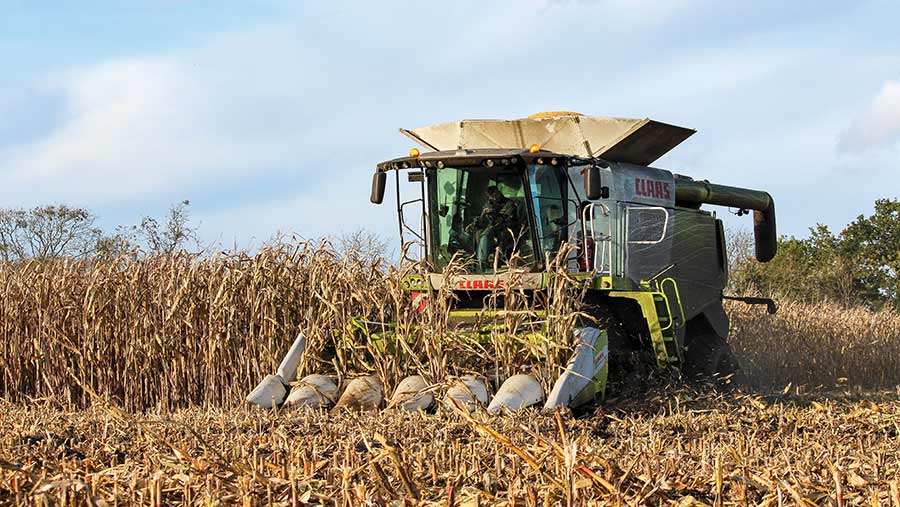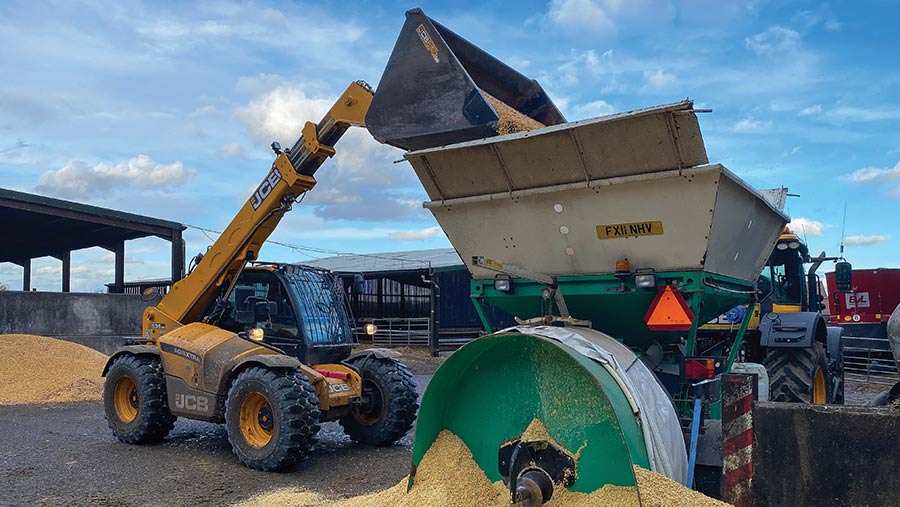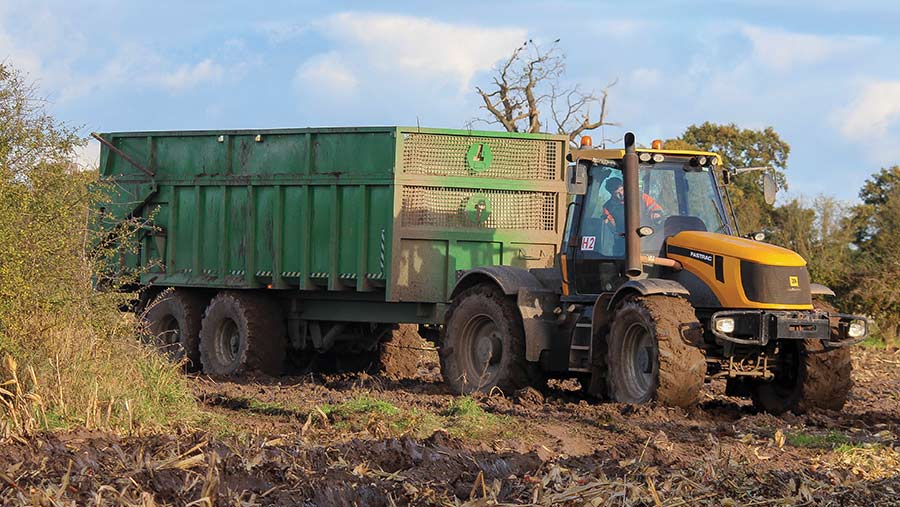Contractor Comment: Foragers parked as Lexion finishes maize
 © MAG/Oliver Mark
© MAG/Oliver Mark Rank autumn weather has made for a rotten maize harvest, but with a tracked combine and Conspeed header at his disposal, all was not lost for Tim Russon.
Rather than having tractors and trailers scrabbling over sodden fields, he sent out the Lexion to pick up the last 180ha of crop.
This tripled his annual grain maize acreage and, for several livestock customers, allowed him to bolt on a crimping service that has gone some way to covering his increased costs.
See also: New Fastrac and trailer investment lifts contractor’s fleet
About the contractor

Tim Russon, Farmers Weekly’s 2020 Contractor of the Year, runs a fleet of foragers to harvest grass, maize and miscanthus.
It was a chaotic conclusion to what has proved an odd season from start to finish, with a tardy and rain-interrupted drilling season making for a staggered harvest that began a week later than usual.
However, things kicked off at pace, with the brace of Jaguar 970s and their new 10-row Orbis headers joined by a year-old 880 to chomp through some massive forage yields.
Single-day outputs topped 7,500t – until the rain arrived.
By mid-October, things had gone pear-shaped, and each foraging team’s 40ha/day average dropped to nearer 20ha.
“We played every trick in the book to keep moving,” Tim says.
“The trailers were only part-filled, we parked up most of the Fastracs and ran conventional tractors instead, and we ballasted everything up with the weight blocks we accumulated in 2019 [the last wet year].”
Efficiency – every good contractor’s stock-in-trade – plummeted and diesel, time and labour expenses shot up, meaning it cost Tim significantly more than he’d budgeted for.
“I haven’t yet analysed the impact it’s had on profit, but we’d made a commitment to customers to get the job done,” he says.
“In the end, we chopped all but 180ha of the 3,240ha of maize we were scheduled to harvest.”
Fortunately, the option of harvesting grain with the tracked Lexion 670 combine proved a handy insurance policy.
It’s a service Tim has offered since 2010, initially in an effort to shore up his maize acreage as dairy and beef customers gradually disappeared.
“To begin with, we were sowing maize under plastic with a Samco drill on arable farms and hauling the crop to livestock areas.
“But then AD plants started appearing, which gave us a ready-made market for forage maize.”
That meant the combining and crimping service took a back seat, rumbling on in a relatively small way until a dismal 2019 harvest led to something of a resurgence.
“That year, I made an impulsive decision to buy a Lexion on tracks, primarily with grain maize in mind,” Tim explains.
The investment has proved worthwhile, with the acreage up from 160ha to a record 540ha this season.
Whether the added combining (£148/ha) and crimping (£16/t) work will cover the extra forage harvesting costs remain to be seen – though Tim is hopeful that it will come pretty close.
Either way, it justified a last-minute decision to buy an eight-row Claas Conspeed header to replace the original six-row unit.
“I went shopping for a bigger header in early November and, fortunately, Claas Western happened to have one that had sat in a shed for three years.
“It will increase our capacity by about 30% and we’ll keep the old one as back-up. It buys us flexibility as it’s a good bit lighter, so it might help us travel when the ground is particularly wet.
“There aren’t many contractors in the east that can combine and crimp, so it’s an option I’m glad to have.”

© MAG/Oliver Mark
Demand for grain maize
Tim expects to have no shortage of work for the new header next season, with the maize acreage likely to rise significantly.
“There aren’t a whole lot of reliable break crop options, winter cereals and beans haven’t been drilled, oilseed rape crops have failed and not everyone can grow sugar beet,” he says.
That, he reckons, could make grain maize a first-choice option, rather than a get-out-of-jail card. There’s also plenty of demand from both livestock farmers and biogas plants.
“A number of AD plants were looking for dried or crimped maize to add into the diet last year – especially when gas prices were high,” he says.
“But we’ll only know the appetite for grain maize early next year.
“Some people will still be hoping, by some miracle, that they’ll get their winter wheat drilled. If they don’t, it will make a compelling alternative to a large acreage of spring barley.”
Miscanthus pending
The bad autumn weather is likely to affect the 1,600ha miscanthus harvest – up 80ha on last year – which will inevitably kick off a few weeks later than usual.
Before then, Tim will be busy fabricating a new custom drum for the forager.
This spins at the same speed as a conventional cylinder but smashes rather than chops the material before laying it on the ground, meaning nothing goes up the spout.
“The old one did eight seasons and is tired, so we’ll start again from scratch,” he says. “I’m also contemplating a design change that will hopefully make it stronger and more durable.”
The Korte 1400 crimper underwent a similar £10,000 revamp in the summer, with a new set of 4mm fluted rollers ensuring it was battle-ready for the unexpectedly high autumn workload.
The rest of the fleet will gradually make its way through the jet wash bays and into the workshop, starting with the JCB 435 shovels.
One will get its seized locking pins sorted, and both will have major services with genuine filters.
Tim says: “I like to fit genuine filters and brake pads unless there’s a massive price difference.
“I’ve had my fingers burnt in the past, with a spurious hydraulic filter damaging the pump on a Fiat 9090, so I consider the £140 extra for genuine JCB filters over aftermarket options a price worth paying.”

© MAG/Oliver Mark
New kit
With a four-year replacement policy on silage trailers, some of the 18-strong fleet will inevitably be moved on this winter.
However, making the numbers stack up is proving trickier than usual.
“Prices have shot up by about £10,000 in three years. Managing rising costs for new models and depreciating values for the ones we have makes the calculations harder.
“That said, the steel price will come down, so I’m tempted to hold off a bit longer.”
Also set to arrive is another Bunning HBD muckspreader – joining two similar models already on the fleet – and a replacement for the 8,500-hour JCB Fastrac 4220.
“It’s now out of warranty and, although it’s been good and reliable, I’m starting to get nervous,” Tim says.
“Ideally, I’d replace it with a Tier 5 Fastrac 4220 if I can find a nearly new one. If not, it’ll be an iCon version – though my research suggests they are a bit thirstier on diesel.”
One investment that has proved worthwhile is Bale Baron’s chamber-shrinking plastic wedges.
These have helped to increase average bale weight by 3kg, which equates to an extra 4t and £400 of straw per wagon. In doing so, the purchase paid for itself in just 10 loads.
Business facts
Main services Grass, maize and miscanthus harvesting, combining, muckspreading, drilling, spraying, hedgecutting, bruising and crimping
Staff Eight full-time plus up to 20 harvest casuals
Kit list
Tractors JCB Fastrac 4220 x4, 2170 x4; New Holland T7.245 x4, T7.200, T6070
Combines Claas Lexion 670 with 7.5m header and Conspeed maize header
Foragers Claas Jaguar 970 x2, 880, 870
Swather Claas Maxiswather
Handlers JCB 435 x2, 416, TM310, 531-70 x2
Sprayer Chafer Rogator 418
Grass MF 1840 conventional with Bale Baron, MF 2150, McHale 660, Kuhn front and rear mower combination, Claas triples, Claas four- and two-rotor rakes, Krone single-rotor rake x2, McHale 998 square bale wrapper, Orbital round bale wrapper
Drills Moore Unidrill 4m, Amazone combination 3m, Horsch Maestro 6m, Kverneland Optima eight-row x2, Amazone Precea eight-row, Weaving IR inter-row grass drill
Diggers Kubota 5.5t, JCB JS 145
Main other kit Bunning muckspreader x5, Bailey silage trailer x18, Bailey dump trailer x3, Bailey lowloader x2, KRM K65 lime spreader, Amazone fert spreader

